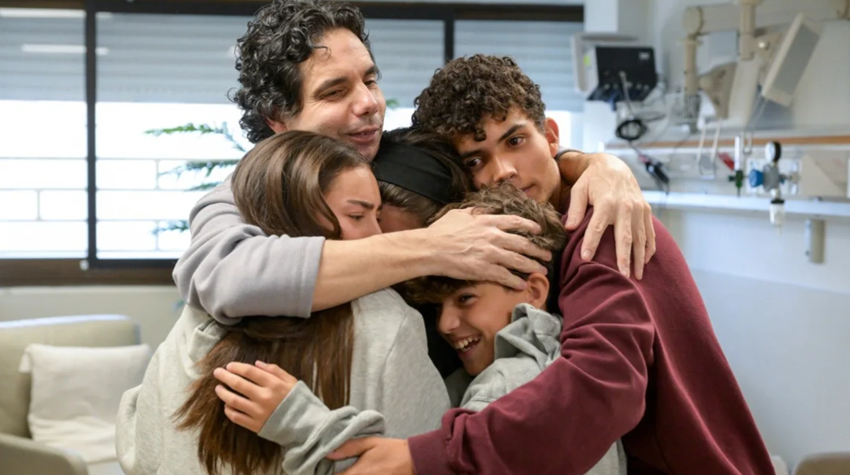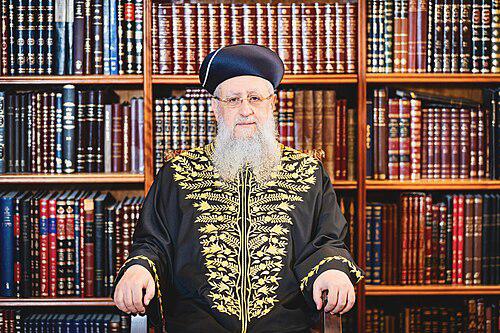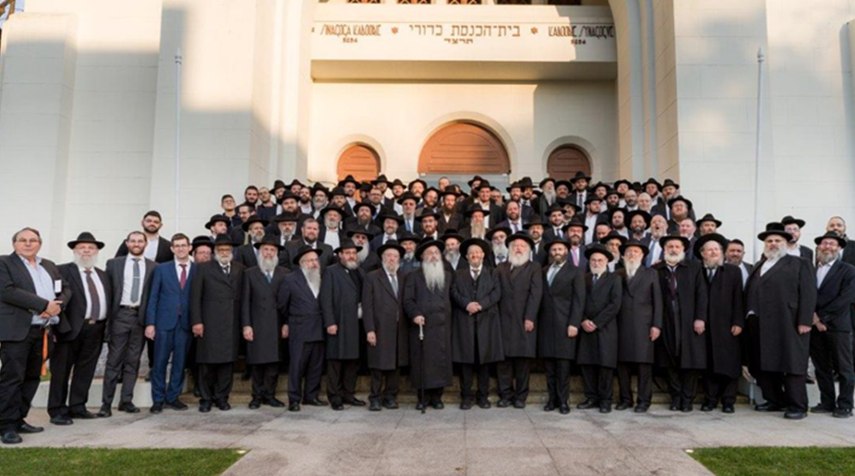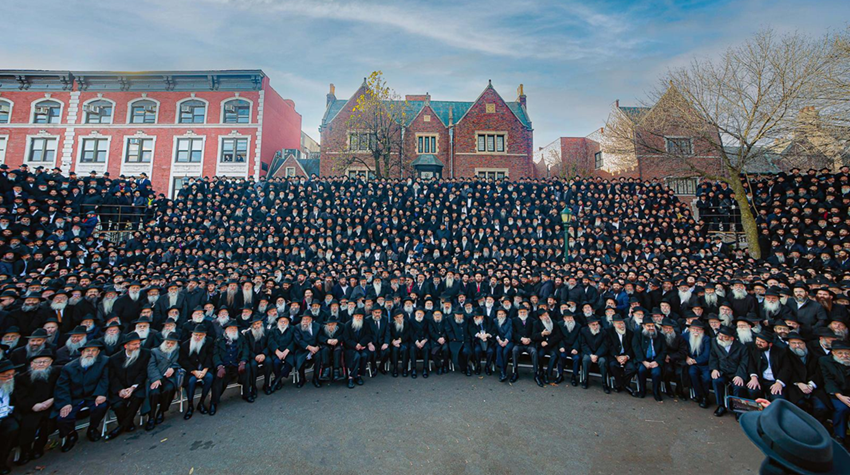Credit: Maayan Toaf/GPO
In his first media interview since his return to Israel, former captive Ofer Kalderon gave a harrowing account of being held hostage in Gaza, the trauma of being separated from his children and his meeting with Hamas leader Yahya Sinwar, whom the Israel Defense Forces later killed.
“You’re alive physically, but you feel dead,” he told journalist Yael Odem on Israeli Channel 12‘s “Ulpan Shishi” program aired on Friday night. “Everything you were before—erased.”
Kalderon, 54, was freed, together with Yarden Bibas and Keith Siegel, on Feb. 1 after 484 days in Hamas captivity in the Gaza Strip. Bibas and Kalderon were handed over by Hamas to the Red Cross in Khan Yunis in southern Gaza, while Siegel was released in Gaza City.
On Oct. 7, 2023, the Kalderon family had been scattered across four homes. As Ofer Kalderon sat terrified in the bomb shelter of their house on Kibbutz Nir Oz with the youngest two of his four children, Sahar, 16, and Erez, 12, their mother, Hadas, was in a separate home in Nir Oz, as was 19-year-old Rotem, while Gaya, their eldest daughter, was living in an apartment in Tel Aviv.
“I heard yelling in Arabic from every direction,” Kalderon recalled. “I realized this was serious. And then I cried like I’ve never cried in my life, because I knew I had no options. I had a cocked pistol, but how do I protect my children like this?”
They managed to escape through the window and hid for two hours behind a bush. “Then I heard the vineyard gate open,” he said. “I told myself: ‘The devil’s come down from the sky, just like that.’”
Surrounded by terrorists, Erez fell asleep, but Sahar saw everything. “We reached a crevice and I realized there was nowhere else to go,” Kalderon said. He woke up his son. “I told Erez, ‘In a few minutes they’ll see us. I’m so sorry, there’s nothing I can do.’ Telling your son that you’re about to be executed—what runs through his head?”
At that moment, Kalderon made a decision that likely saved his life. “I handed one of the Arabs my gun so he wouldn’t kill me and Erez,” he recounted. “They separated me from Erez. One of them told me to get on the ground. He wanted to execute me in front of my son.
“I started jumping and shouted in Hebrew, ‘I didn’t do anything to you!’ That was my instinct,” he said. “It shifted something—the energy, perhaps. Then a big guy came and grabbed me by the neck. They all started beating me.”
He continued, “Erez stood there, watching them beat his father. I tried to look at him, but afterward, they didn’t let me. A large man dragged me by the neck. I tried to resist, but I was scared. What about Erez? What about Sahar? I saw her out of the corner of my eye on a scooter, lying between two men, completely terrified. Erez disappeared—I couldn’t see him. I tried to turn around and they wouldn’t let me.”
Taken to Gaza
“I assumed everyone was dead—Sahar, Erez, Rotem, Hadas. But there was no time to mourn,” Kalderon said of his journey to Gaza, lying beneath a terrorist in a pickup truck. “Once we entered the tunnel, every part of my body hurt. I realized there were more Nir Oz people …, but then they separated us. They decided I was a ‘high-ranking officer.’”
He added, “I hobbled for an hour and a half in tunnels, into a real prison. I was alone in the cell, shirtless, freezing. Then they brought Matan Zangauker. Later, I was moved to a cell with Jimmy [Pacheco] and Yarden [Bibas]. The three of us were there for two weeks, squeezed onto three grimy, foul-smelling mattresses.”
After three weeks, Kalderon was moved again. This time, he met Rimon [Buchshtab-]Kirsht from Kibbutz Nirim—and heard something astonishing. “She told me Sahar Kalderon had been with her. I started crying.”
He begged the guards to take him to Sahar. Around the same time, her guard asked her: “What’s your dad’s name?” A few minutes later, she saw her father, limping and skinny. “I was in shock, but then we started talking. Then we heard a missile strike nearby, the house shook, and they took us into the tunnel again.”
Those three hours were the only time, Kalderon said, that he was outside a tunnel during his captivity. “There we had no control,” he said. “Suddenly, this dad who always had answers—helpless.”
Kalderon and his daughter were held together in a Khan Yunis tunnel, along with three others who are still in captivity, and with senior Hamas leaders. They had no idea what happened to Erez, Rotem or Hadas. “I befriended the Khan Yunis commander,” said Kalderon. “He told me Erez was hospitalized. We sent a message: ‘Sahar and I are OK.’ Erez was told his father couldn’t come.”
“One day, we saw Hadas on TV, speaking on a stage in Israel. Sahar and I cried. It was surreal. Underground, watching her speak in Israel. I didn’t know Rotem was alive until two weeks before I was released. I’d dreamed of gravestones with his name. But something in me said he was alive.”
Meeting Sinwar
After his two children were released in the first hostage deal in November 2023, Kalderon was taken to a tunnel with fellow captive Yarden Bibas. He was present when Bibas was told that his wife, Shiri, and his children, Ariel, 5, and Kfir, 2, were all murdered by Hamas.
It was there that they met Hamas leader Yahya Sinwar, who was later shot dead by IDF soldiers on Oct. 16, 2024. “He passed through the tunnel and spoke with us. I recognized him immediately. I asked him: ‘What now? Are talks over?’ He said: ‘Things are a bit delayed. Be patient. In a month, it’ll be OK.’ That’s what he said—a month.”
Kalderon was subsequently moved to a different tunnel with fellow hostages Sagui Dekel-Chen, David Cunio and Eitan and Yair Horn. When the IDF bombed the tunnel, they were moved to another location. “A 70-cm.-wide [27-inch] tunnel, mattresses laid one after the other. We lay there for almost two months, with constant explosions.”
They barely ate, he said. “Salty water for 24 hours, and a thin saj bread. I’d split it, stash half in my pocket and eat it crumb by crumb. It felt like Holocaust stories. No toilets—you had nothing in you. We peed in bottles. The stench was unbearable. We each lost over 20 kilos [44 pounds].”
In the unbearable pressure of the tunnels, surreal moments emerged. “I raised spiders,” Kalderon shared. “I fed them ants. One day, I saw my captor pull out a pink bottle with a green cap: Pnina Rosenblum cream. He’d rub it on before every prayer. Five times a day, smelling great.”
‘The Cookie Junction’
Months later, after an exhausting 13-hour, 20-km. trek through tunnels, they came across cookie boxes. “No one asked permission; we devoured them. I opened packet after packet, stuffing date cookies into my mouth. I called it ‘The Cookie Junction.’ We shoved cookies in every pocket. Then, we found bottles of mineral water. They said, ‘Don’t bother — there’s plenty ahead.’ But I took two bottles, held them tight and kept walking.”
Eventually, someone whispered to him: “You’re going to Yarden.” After seven months apart, they were reunited. “He looked good—skinny, but handsome. We spent eight months together. Played cards, talked, but mostly—deathly silence.
“I insisted on seeing the news. I begged until one captor filmed the TV for me,” said Kalderon. “I saw my cousin Yifat on screen. She said I was on the list of 33 hostages and added, ‘Your four children await your embrace.’ That’s when I knew: Four means Rotem is alive.
“Then someone came in shouting: ‘Yarden Bibas, you’re going home! Ofer Kalderon, you’re going home!’” They were euphoric. “Yarden was in shock. The guard told him: ‘Why are you sad? Start a new family, who cares?’ That’s their mindset.”
“They told us we’d walk for an hour in the tunnel. I hoped I’d survive the hour. I couldn’t do anything. Even a shower was exhausting. You’re told you’re leaving; it’s madness. But what awaits at home? You’re terrified. You want to leave, but you’re afraid of what you’ll find.”
“You walk two hours, but you’re walking toward life. When I emerged, I crawled out on all fours. I couldn’t walk. It was terrifying. After 16 months underground, you’re outside and you can’t see, only hear. The first sound I heard was baby chicks in someone’s yard.”
Haunted by Gaza
As efforts are underway for a deal between Israel and Hamas that could pave the way for the remaining 50 hostages, 20 of whom are believed to be alive, Kalderon said that Gaza follows him everywhere. “I can’t sleep. When I do, I wake up after an hour from booms. Bad thoughts all the time. I lock the door twice in Kiryat Gat [where he now lives]. I never used to.”
His biggest trauma? The separation from Erez, he said. “We’ve never spoken about it. He refuses therapy. [The children] went through abandonment, even if it wasn’t my fault. I tortured myself over it for weeks in captivity and could do nothing.”
Source: JNS
































